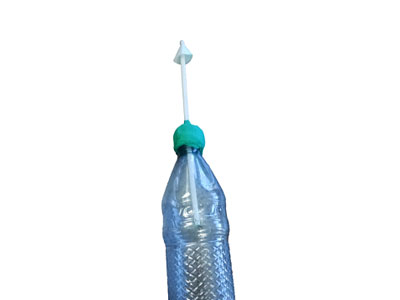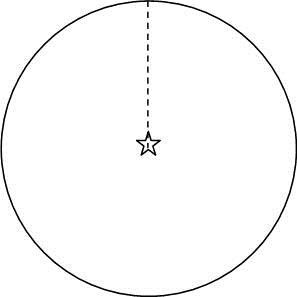How can I make a bottle rocket?

Bottle Rocket

Bottle Rocket
How does this align with my curriculum?
Use a pop bottle and other everyday materials to create a rocket that you can launch outdoors.
What You Need
- 600 mL pop bottle
- Circle tracer
- Pencil
- Plasticine
- Cotton swab (e.g. Q-tip)
- Scissors
- Scrap paper
- Straw
- Tape
Safety First!
Never fire a bottle rocket in the direction of another person, especially someone’s face.
What to Do
- Roll the plasticine into a “walnut”-sized ball and press down with the heel of your hand to flatten.
- Place the plasticine across the opening of bottle and mold it around the outside of the bottle’s opening to form a seal.
- Poke the straw through the plasticine so that half of the straw is outside bottle and half is inside bottle. Mold the plasticine around straw.
- Using the compass, trace and cut out a circle shape (5 cm across) on paper. Cut into the middle of the circle and fold one flap over the other until a cone shape is formed. Use a small piece of tape to hold the paper cone together.
- Cut a small hole at the point of the paper cone and fit the head of a cotton swab head through it.
- Place the cotton swab with its attached paper cone inside the top of the straw.
- Point your rocket away from yourself and other people and give the bottle a hard squeeze.
Discovery
Air takes up space. There is air inside the bottle before you squeeze it. When air is compressed its pressure increases, so when you press on the sides of the bottle, you are increasing the pressure inside it. Air does not like high pressure situations, so it tries to move to an area of low pressure (in this case, outside the bottle). The air rushes out through the straw and causes the rocket to zoom and “take off!”
Air pressure is an important dynamic in our lives. Though it is difficult to feel, the air around us is not always at the same pressure. At higher altitudes (like on mountains), the air becomes "thin" because the pressure decreases so much. In those cases, it may become harder to breathe.
Similarly, air pressure is used by meteorologists (scientists who study the weather) as an indicator of the weather. Low pressure systems are prone to rain, whereas high pressure systems tend to be sunny. This is why weather reports talk about high or low pressure fronts. By determining how the air travels between high and low pressure areas (remember, air likes to move towards low pressure areas), meteorologists are able to estimate wind speeds and temperature changes.
- Measure how far your rocket can fly.
- Design a target and determine how accurately you can fly your bottle rocket by attempting to hit the centre of the target.
- Listen to a weather report to hear how a meteorologist talks about high and low pressure zones in relation to the weather.
For more information on this topic check out these Let's Talk Science resources:
- How do vacuum cleaners work? (Hands-on Activities) - Discover the type of pressure that is used in a vacuum cleaner.
What’s happening?
Air takes up space. There is air inside the bottle before you squeeze it. When air is compressed its pressure increases, so when you press on the sides of the bottle, you are increasing the pressure inside it. Air does not like high pressure situations, so it tries to move to an area of low pressure (in this case, outside the bottle). The air rushes out through the straw and causes the rocket to zoom and “take off!”
Why does it matter?
Air pressure is an important dynamic in our lives. Though it is difficult to feel, the air around us is not always at the same pressure. At higher altitudes (like on mountains), the air becomes "thin" because the pressure decreases so much. In those cases, it may become harder to breathe.
Similarly, air pressure is used by meteorologists (scientists who study the weather) as an indicator of the weather. Low pressure systems are prone to rain, whereas high pressure systems tend to be sunny. This is why weather reports talk about high or low pressure fronts. By determining how the air travels between high and low pressure areas (remember, air likes to move towards low pressure areas), meteorologists are able to estimate wind speeds and temperature changes.
Investigate further
- Measure how far your rocket can fly.
- Design a target and determine how accurately you can fly your bottle rocket by attempting to hit the centre of the target.
- Listen to a weather report to hear how a meteorologist talks about high and low pressure zones in relation to the weather.
For more information on this topic check out these Let's Talk Science resources:
- How do vacuum cleaners work? (Hands-on Activities) - Discover the type of pressure that is used in a vacuum cleaner.
